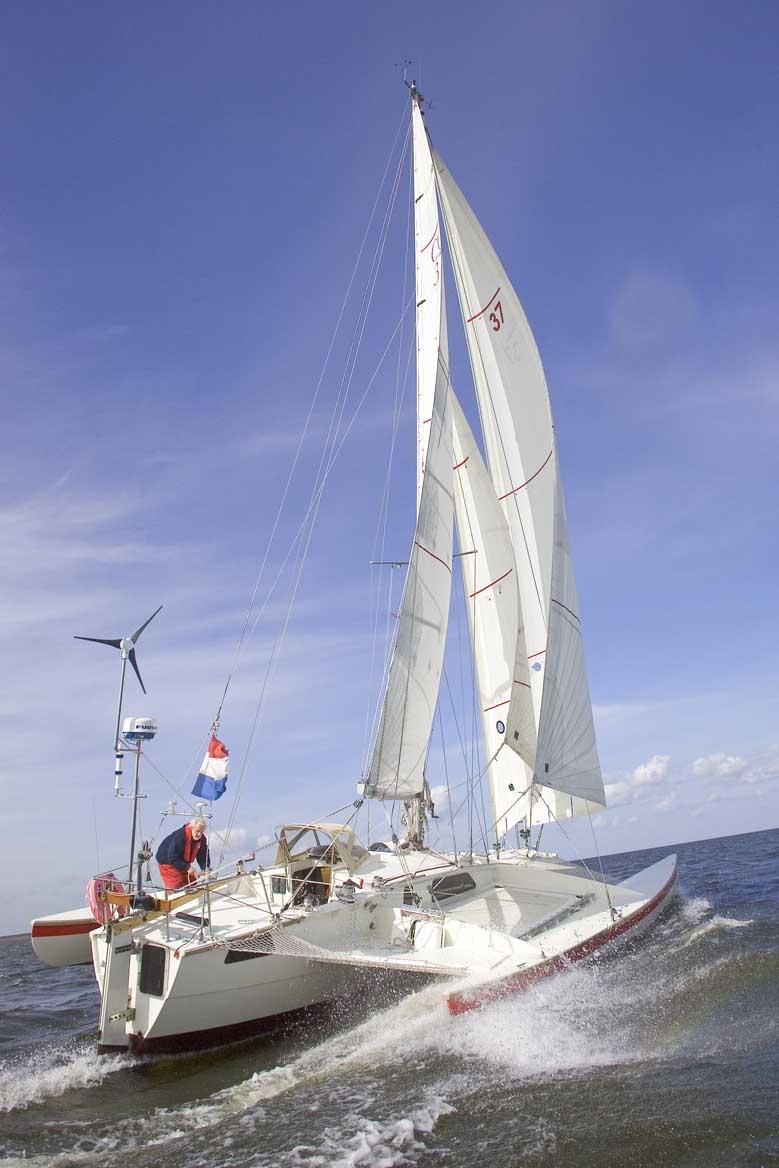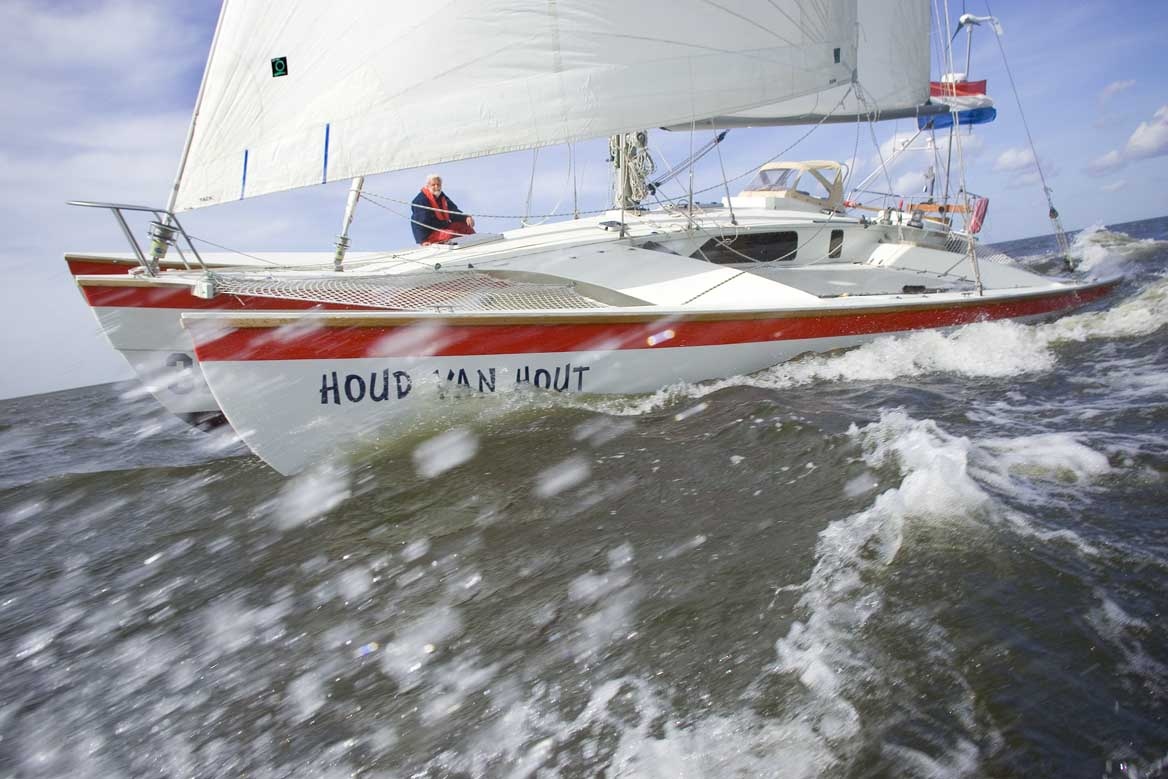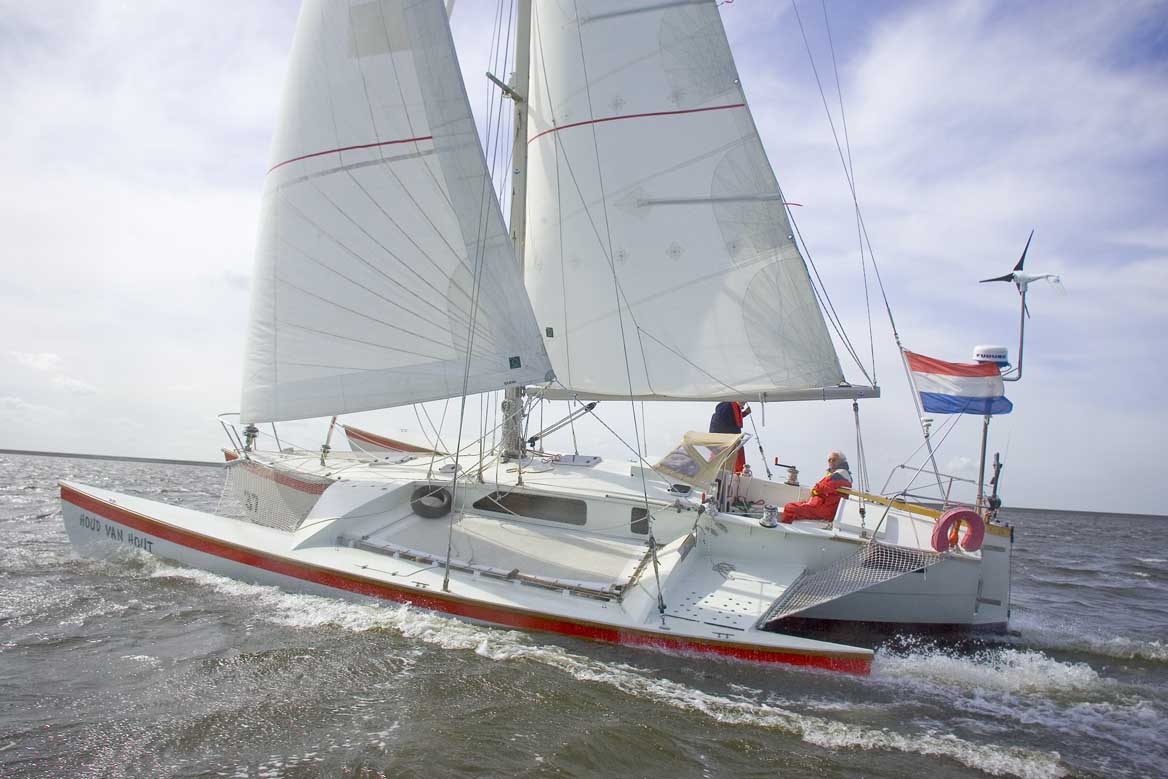Featured here is some info about a CC37FC trimaran … self-built and sailed by Leon Bart. The CC37 is a John Marples designed sailboat that is constructed using the Constant Camber building technique.
Leon wrote and shared the following about his boat. Many thanks Leon!
………….
Following are images of the HOUDvanHOUT (what means I love wood) — my baby. She was build and launched in 2003. Winner of the OSTAR 2005 in her class and holder of the “Lizzy Mc.Mullen Trophy”.
I published an e-book unfortunately in Dutch, but with lots of fotographs (about the building and a complete recording of the 2005 OSTAR race). You can order the e-book on “www.watersportmedia.net” (go to web shop); Title: “Gedreven door hout” undertiteled “the OSTAR from fir to finish”.
 Since the OSTAR we also sailed the “Round Britain and Ireland” in 2006 and came in second, also on handicap. After this race we sailed cruising to the Med and did it all the way to Turkey and back to the Netherlands. Now she is back in her home marina Lelystad (Netherlands IJsselmeer).
Since the OSTAR we also sailed the “Round Britain and Ireland” in 2006 and came in second, also on handicap. After this race we sailed cruising to the Med and did it all the way to Turkey and back to the Netherlands. Now she is back in her home marina Lelystad (Netherlands IJsselmeer).
My interest in multi’s started early, already in the seventies and my first multi was a Wharram (Tane). In 1983 I launched my Farrier designed “Trailertri 680”, she was the first one here in the Netherlands. Jim Browns “Searunner Construction Manual” was a great help and also recommended by Farrier in those days. Farriers are now the most popular multis here around.
In 2001 I started building the HvH specially for the OSTAR. My first intention was to build a 34 ft Seaclipper for this particular race, but after correspondence with Marples, who convinced me about building in Constant Camber, I decided on his CC37FC, also because I found some important funds to finance the whole project.
As you can understand I am a devoted multihuller and specially interested in all kind of multihull stories, old or new doesn’t matter. Just got “The case of the cruising trimaran”, nice stuff and still not outdated! It is only a pity that the print (photo’s) is of such a bad quality but I really like the stories and drawings. I also like all the Jim Brown U-tubes on the internet it is a real documentary.
It took me 4 years to build the HvH. She sails great and is a very good long distance cruiser/racer. Her speed very much depends on all the stuff (cruising gear) you have to take with you.
In racing mode (as light as possible), with a flat sea, all sails up and in a good force 5 to 6, she is doing 15+, sometimes up to 20. When the lee float is immersed enough (when you push her hard till the deck of the lee float is almost under) she will accelerate because the main hull is lifted a bit and her speed comes in the much higher (15+) regions. Actually it is not necessary to touch the helm any more because she is in a completely balanced situation.
The buoyancy of the floats, especially in the bows is big enough to withstand the tendency of burying even when you surf into a wave trough.
Her cutter rig is very practical and in my opinion the only rig for serious sailing at sea. Completed with a a-symetrical spi (114m2) and genneker (85m2) she is also achieving good speeds in light airs.
I never used my parachute anchor but under 40knts+ conditions I followed the tactic of waiting for better conditions under bare poles as long there is sea room enough of course. She behaves like a raft and although drifting sideways, the ama floatation prevents her from capsizing.
Nowadays with the ability of receiving (gribfiles via irridum satellite telephones) it is possible, with a reasonable fast sailing vessel, to avoid real bad wheather conditions, because you can sail away from the worst before it will reach you, what makes the use of a parachute less important.
After the invention of GPS, I think the invention of receiving reliable weather forecasts are the two most important inventions for seafarers to make life at sea much easier.
What I don’t like about the HvH is her maneuverability in tight windy conditions under engine. She is very sensitive to wind conditions and sometimes I wish I had outfitted her with a stronger engine. The 18hp 2 cil. Yanmar (2GM) with the MAXprop (vane folding) is sometimes a little to less under windy conditions, although this combination is fine under lighter conditions.
It is rather hard to maneuver backwards and she needs quite some room to turn.
Kind regards,
Leon Bart





0 Comments